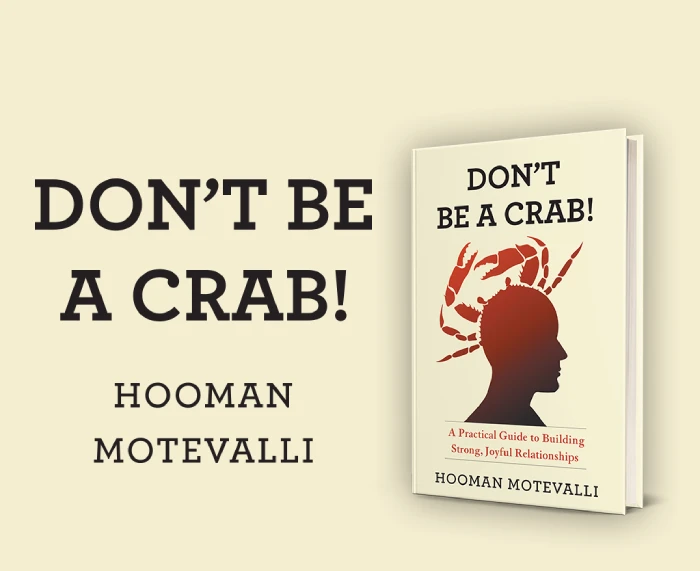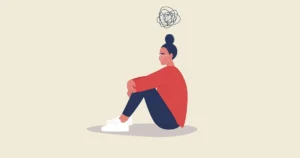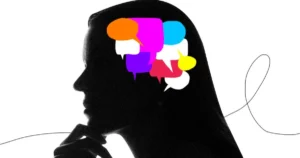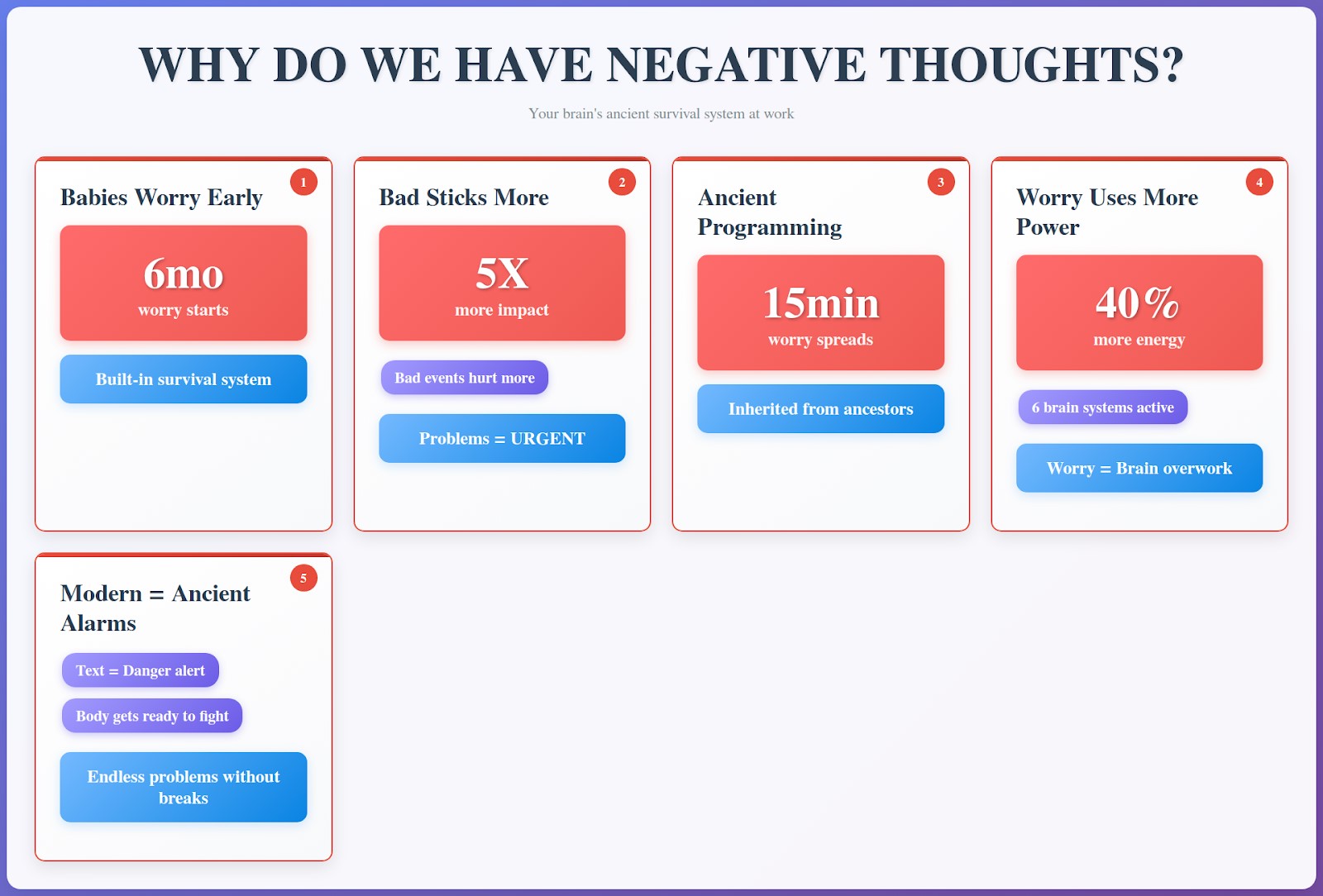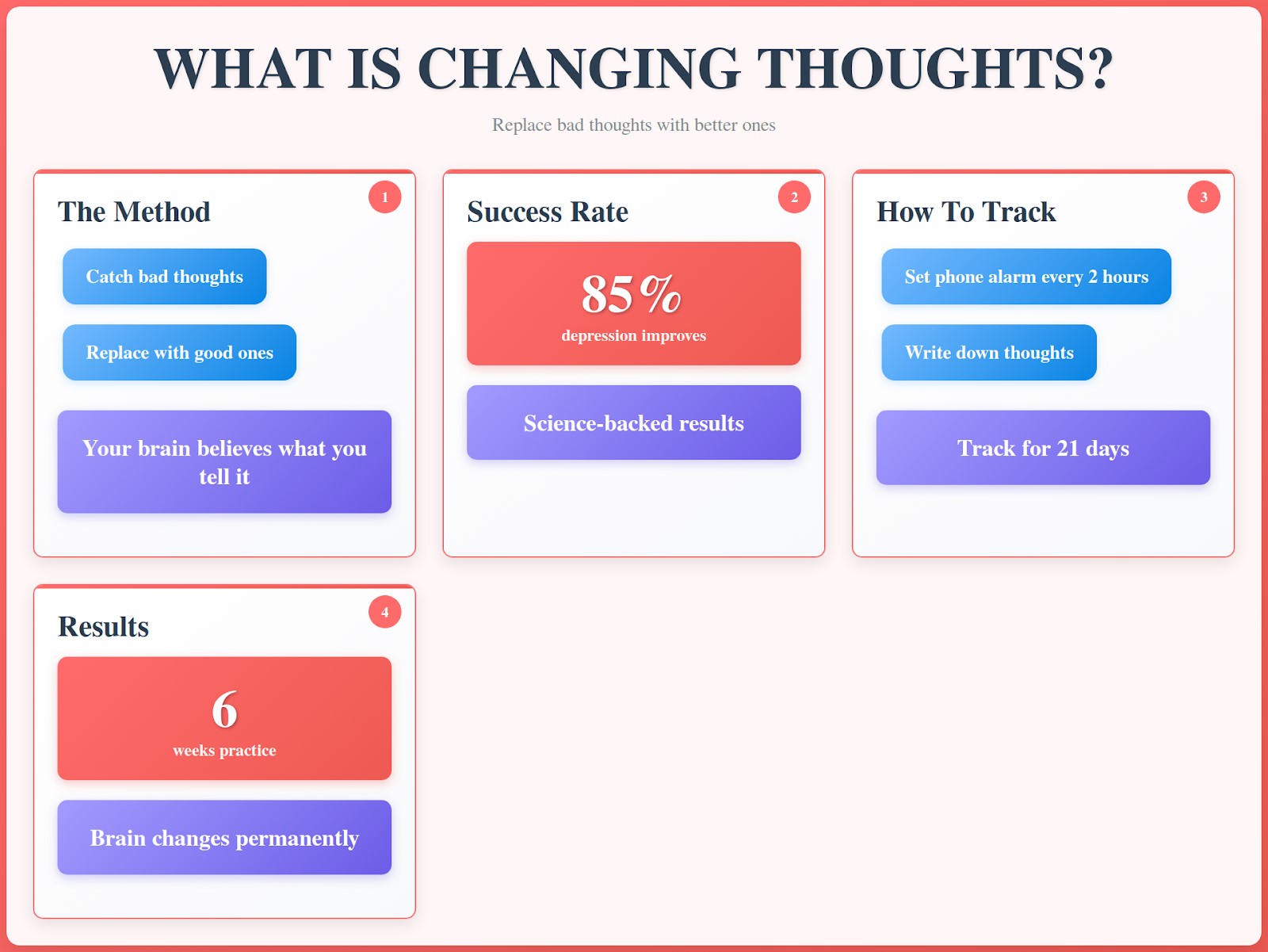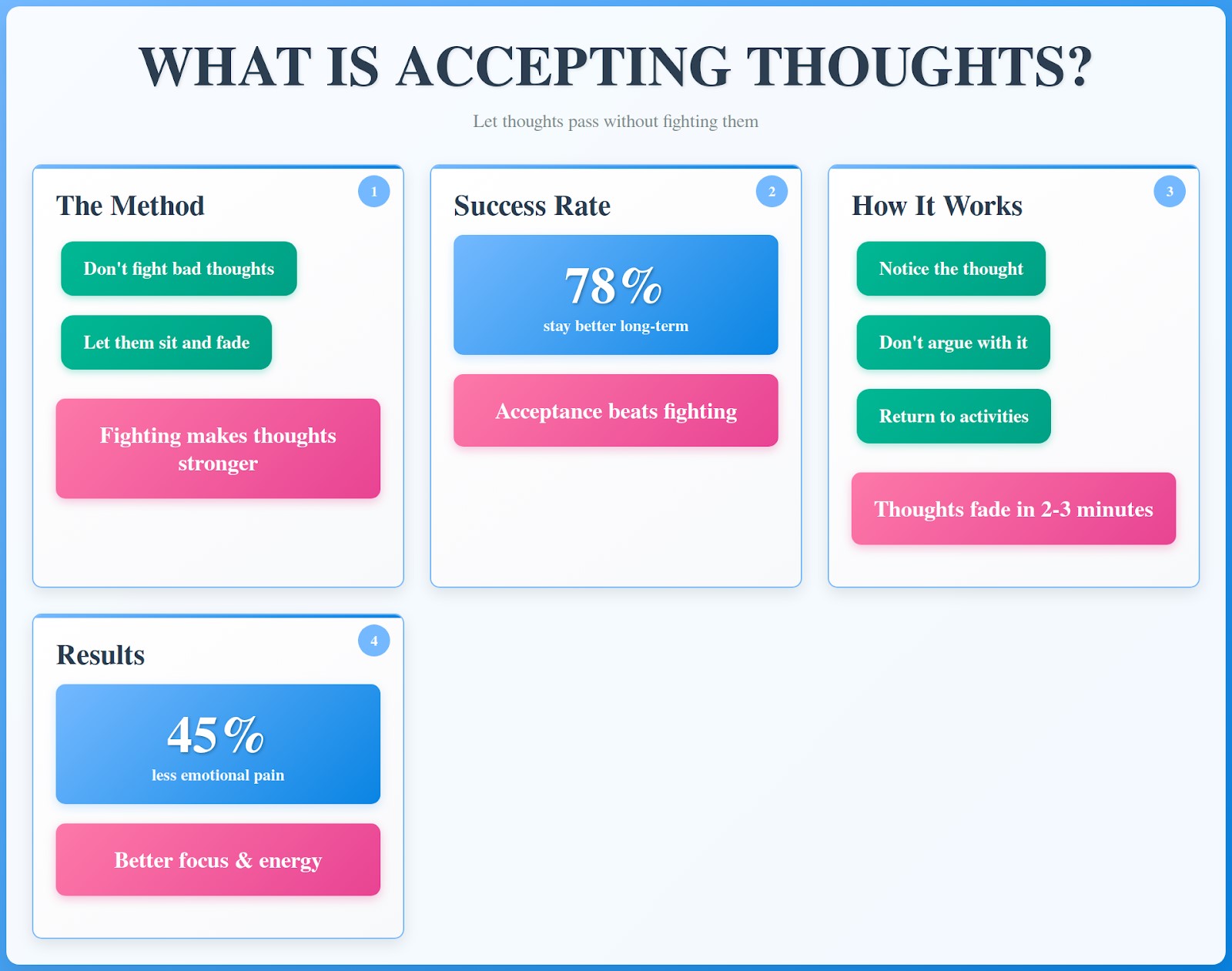You might be thinking that changing your negative thoughts makes you a fake person. Or it might feel more honest and real to you to accept all of your thoughts. But what if, based on the situation, both ways are correct?
Troy did tests on 170 people and found that fighting thinking doesn’t always work, but sometimes it does. Also, Kashdan says smart people mix the two ways of doing things instead of sticking to one for all time.
In reality, neither way makes you fake; being real means picking the right answer for each scenario.
Why Do We Have Negative Thoughts?
Your brain makes negative thoughts to keep you safe. Everyone has them because that’s how human brains work.
1- You Start Worrying Before You Can Walk
In fact, babies worry before they can even sit up. Vaish watched 300 babies and found something important. She showed them happy faces and angry faces, and the babies looked at angry faces for 4 minutes but only looked at happy faces for 1 minute.
This tells us something big:
- Parents and school didn’t teach you how to worry.
- Stress was built into your brain from birth.
- You were already looking for trouble before you even spoke.
- This system starts working at 6 months old
| Baby Age | Time Spent Looking at Scary Things |
|---|---|
| 6 months | 75% longer than happy things |
| 9 months | 80% longer than neutral things |
| 12 months | 85% longer than positive things |
So when you worry about things today, remember this started when you were tiny.
2- Bad News Sticks Better Than Good News
Baumeister looked at 10,000 people to see how things happen to them. He learned that bad things hurt 5 times more than good ones. It stays in your mind for days after someone says something mean to you, and you just forget nice things in two hours, though.
His research showed this happens everywhere:
- One bad customer review hurts a business more than 10 good reviews help it
- Losing $50 makes you upset for a week
- Finding $50 only makes you happy for an hour
- Your brain treats bad information as more important than good information
The reason is simple. Your brain files away problems under “urgent” but files away good news under “maybe later.”
3- Your Brain Inherited Ancient Programming
Why does your brain work this way? Rozin explains that humans who ignored danger died fast, and the ones who worried about every sound and shadow lived long enough to have children. So, you inherited a worried brain from worried ancestors.
Your great-great-great-grandparents survived because they expected the worst, and they passed this programming down to you. Now your brain still acts like every problem could kill you, even though most modern problems won’t hurt you at all.
Rozin also discovered that negative feelings spread between people faster than positive feelings:
- When one person in your family starts worrying, everyone else feels worried within 15 minutes
- When someone shares good news, it takes hours for others to feel happy about it
- Your brain automatically copies other people’s emotions
4- Worry Uses More Brain Power Than Happiness
Cacioppo watched how people’s brains worked while they were feeling different moods, and he found that worry and happiness are not the same in important ways:
When you worry:
| When You Worry | When You Feel Good |
|---|---|
| Uses 40% more energy | Uses normal energy |
| Creates memories that last months | Creates memories that fade in days |
| Activates 6 brain systems | Activates 2 brain systems |
| Keeps you awake thinking | Lets you relax easily |
5- Modern Problems Trigger Ancient Alarms
You’re old-fashioned brain can’t tell the difference between real danger and normal stress. According to Baumeister, people react to stress at work in the same way that cavemen responded to wild animals.
For example, the moment your phone vibrates with a text, your body gets ready to fight or run:
- Your heart beats faster
- Your muscles tense up
- Your breathing changes
- Your stomach feels tight
But there’s no real danger, just a message from a friend. But your brain treats both situations as emergencies. In the end, this alarm creates ongoing stress because modern worries never end.
Better to say that your ancestors faced a dangerous animal, dealt with it, and then relaxed for days. But you face problems that keep coming without breaks:
- Emails that need answers
- Bills that need paying
- Social media drama
- Work deadlines
What Is Changing Thoughts?
Changing thoughts means you catch bad ideas in your head and put good ones instead. When you think “I’m stupid,” you should stop and think “I made a mistake, but I can learn.”
This happens every day. You’re walking into work and think “Everyone hates me.” That thought makes you feel terrible. So you change it to “Some people like me, some don’t. That’s normal.” Now you feel better.
There is good science behind this. When people do this, their depression gets 85% better. Butler examined 16,000 people and got the following outcomes for various problems:
| Problem | How Much It Got Better |
|---|---|
| Feeling sad all the time | 85% improvement |
| Worry and panic | 78% less anxiety |
| Fear of people | 76% more confidence |
| Physical pain from stress | 82% pain reduction |
Your brain believes what you tell it repeatedly. When you keep thinking negative thoughts, your brain thinks that’s reality. But when you practice better thoughts, your brain starts believing those instead.
How to Actually Change Negative Thoughts?
Set a phone alarm for every 2 hours during the day. When it goes off, write down what you were just thinking. Do this for one week. Then you’ll see patterns in your thoughts.
Oettingen found that people who track their thoughts for 21 days start changing them automatically. 94% of people get better results when they write things down instead of just trying to remember.
Anytime you have a bad thought, do this:
- Step 1: Write the exact thought on paper
- Step 2: Rate how true it is from 1-10
- Step 3: Write down what actually happened (facts only)
- Step 4: Write a new thought based on the facts
- Step 5: Practice saying the new thought 3 times out loud
Motevalli teaches people to carry a small notebook everywhere. When you feel upset or worried, write down immediately what triggered it.
Then you work through the 5 steps. He found that 6 weeks of daily practice changes how your brain works.
What Are Accepting Thoughts?
Accepting thoughts means you don’t fight with bad ideas in your head, and let them sit there till they go away by themselves.
Most people try to push away negative thoughts, and this makes things worse. Marcks tested 106 people and saw that fighting thoughts create more stress, and people who stopped fighting their thoughts felt better within a few weeks.
Your brain works backwards when you fight thoughts. The more you say “stop thinking this,” the more your brain thinks about it.
Woods discovered that unwanted thoughts come back 3 times stronger when you try to block them.
How to Accept Your Thoughts?
Motevalli says that people should watch their thoughts without getting involved with them. You see the thought, know it exists, then go back to your daily activities. Here’s how it works with a real example:
You’re scrolling social media and see everyone posting about their perfect vacations. Suddenly, you think, “My life is boring and everyone else is happier than I am.”
- Step 1: Notice the thought immediately and say, “I just had the thought that my life is boring.”
- Step 2: Don’t argue with it or try to prove it wrong because most people start listing reasons why their life isn’t boring.
- Step 3: Accept your brain is trying to help and say, “My brain is comparing my life to others because it thinks this will motivate me to improve.”
- Step 4: Return to what you were doing. Continue scrolling, make dinner, or do whatever you planned next.
Another example is that you make a small mistake at work and think, “I’m terrible at my job and everyone noticed.”
Wrong way to handle it:
- Try to stop thinking about it
- List all your work achievements to prove the thought wrong
- Keep replaying the mistake in your head
The right way to handle it:
- Notice you’re having a self-critical thought
- Say, “This is my brain being extra careful about work performance.”
- Focus on your next task while the thought fades naturally
Segal noted that after 3 weeks of using this method for 10 minutes every day, people noticed real changes. The brain learns that thoughts don’t need answers or actions right away.
| Week 1 | Week 4 | Week 8 |
|---|---|---|
| Thoughts feel very urgent | Thoughts feel less important | Thoughts feel routine |
| Strong emotional reactions | Moderate reactions | Mild reactions |
| Takes effort to accept | Acceptance feels easier | Acceptance happens automatically |
Why Fighting Thoughts Doesn’t Work?
When you have a negative thought, your first reaction is to get rid of it fast. This reaction seems smart, but it backfires every time because our brain treats the thought as more important when we fight it.
Segal studied people with depression for 12 weeks. Those who learned acceptance stayed better 78% of the time, while those using other methods only stayed better 34% of the time. It shows that acceptance works much better than fighting. The difference is huge:
Fighting thoughts create:
- More negative thoughts every day
- Higher stress levels all the time
- Worse sleep at night
- Problems with family and friends
Accepting thoughts creates:
- 45% less emotional pain after 8 weeks
- Better focus on daily tasks
- Stronger relationships
- More energy for fun activities
Teasdale says that acceptance takes the pressure off of thinking since thinking about something scary, like any other thought, stops your brain from sending fear messages.
This is because your brain does two things at once. One part naturally comes up with ideas. Another part decides which thoughts matter. When you accept thoughts, you tell your brain these thoughts don’t need special attention. This shift in emotional control, like the kind explored in Conquer Your Emotions: A Practical Guide To Control Your Anger, helps reduce reactivity and brings calm without forcing thoughts to disappear.
Which Way Works Better?
Fight thoughts when you can fix things, accept thoughts when you can’t. Troy tested 170 people and discovered that fighting works for fixable problems while accepting works for unfixable ones. And it makes perfect sense because your brain needs different responses for different situations.
Also, Kashdan believes flexible people stay mentally stronger than those who stick to one approach. Using the same method all the time backfires completely.
Small mental habits that reduce stress, like the ones shared in Don’t Be a Crab, help you stay flexible, calm, and realistic without getting stuck in one approach.
In addition to other examinations, Aldao studied 1,317 people and proved this point clearly. The smartest approach is matching your method to your situation, which Bonanno found cuts stress by 50%.
| Can Fix the Problem | Can’t Fix the Problem |
|---|---|
| Fight thoughts → Take action | Accept thoughts → Save energy |
| 40% less depression | 60% better mental health |
If You Can Fix It – Fight Your Thoughts
Real situations where fighting works:
- Your bank account is low → Budget better, find extra work
- Your boss seems angry → Schedule a meeting to talk
- You gained 15 pounds → Change your eating, start exercising
- Your relationship feels distant → Plan date nights, communicate more
Fighting controllable problems gives good results. Kashdan explains that 3 out of 4 people solve them within 6 weeks. The reason is simple: fighting gives you the energy to take action. Once you fix the actual problem, your thoughts stop bothering you completely.
If You Can’t Fix It – Accept Your Thoughts
Nothing you do will change some situations, so fighting thoughts about them just wastes your time. Bonanno realized that accepting unchangeable situations helps people heal 70% faster.
Situations where accepting work:
- Your ex moved on with someone else → Let the hurt feelings pass
- Your parent has dementia → Accept the sadness without fighting it
- You got fired from your dream job → Allow disappointment to fade naturally
- Your friend doesn’t text you back → Stop analyzing why and move on
Most people waste way too much time on things they can’t control. Aldao found that people waste 3-4 hours daily fighting unchangeable things. However, acceptance frees up this mental energy for things you actually control.
How To Make A Quick Decision?
Ask yourself: “Can I change this in 2 weeks?” If yes, fight the thought and make a plan. If no, accept the thought and focus elsewhere.
This 2-week rule works incredibly well in practice. Troy also tested it with 85 people, and those who used it correctly improved their mental health by 45% in just one month.
In fact, the rule works because 2 weeks gives you enough time to take real action on fixable problems. Meanwhile, it prevents you from wasting months on impossible situations.
When to fight (you can change it in 2 weeks):
- Money problems you can fix with budgeting or extra work
- Relationship cases you can discuss and solve
- Health problems you can treat or improve
- Work skills you can practice and get better at
When to accept (you can’t change it in 2 weeks):
- Other people’s opinions about you
- Things that have already happened in the past
- Family members’ personality or choices
- Natural disasters or unexpected events
People who master this switching ability get amazing results. Kashdan uncovered that these people have relationships that last 3 times longer and earn 25% more money.
FAQs
How do I know if I can actually control a situation?
Ask yourself if you can change things within 2 weeks through your own actions.
What if I keep switching between accepting and fighting the same thought?
Focus on the specific piece you can actually change instead of the whole situation. Kashdan found that 60% of people face mixed situations where some parts are controllable and others aren’t.
Will accepting negative thoughts make me lazy or unmotivated?
Accepting unchangeable situations saves energy for things you can control.

